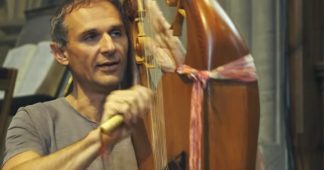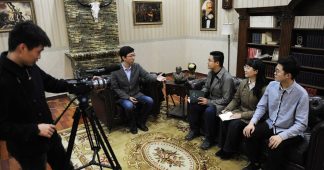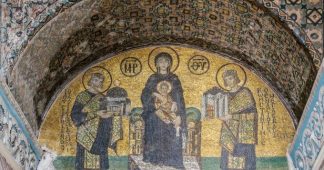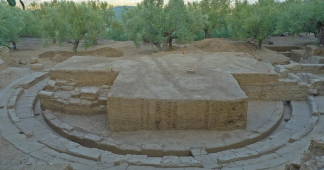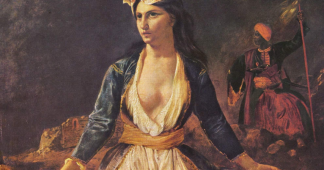By Patricia Claus
A tapestry depicting the Italian painter Raphael’s masterpiece, featuring great figures from ancient Greek history, is once again adorning Plenary Hall in the French Assembly, or parliament.
Watching over legislators, all the greatest philosophers and scientists representing the glorious past of Greece and Renaissance Europe will once again serve as a reminder to keep the high ideals of democracy and ethics always in mind.
After extensive restoration by the firm MNGBS, the tapestry was revealed in all its splendor on Tuesday during a plenary session of the French Parliament.
The painting has long been considered to be “Raphael’s masterpiece and the perfect embodiment of the classical spirit of the Renaissance,” according to art historian Horst Woldemar Janson.
In his original work, the Italian master depicted some of the greatest thinkers throughout antiquity, including Aristotle, Plato, and Socrates, as well as other philosophers, as if they had all lived at the same time and were able to converse with each other.
He also portrayed sculptures of the Greek gods Athena (portrayed as the Roman goddess Minerva), representing Wisdom, and Apollo, representing Light and Music, in a direct nod to the greatness of Greek mythology and its contributions to the western world.
The original painting was created between 1510 and 1511 to adorn the walls of the Vatican’s Apostolic Palace. The tapestry, which is a faithful representation of the painting, measures 4 meters (13 feet) high and 9 meters (30 feet) wide.
The School of Athens contains a wealth of elements meant to represent themes from history and how they are interwoven with each other. One of a group of four frescoes which depict separate branches of knowledge, figures on the walls of the painting exemplify the realms of Philosophy, Poetry and music, Theology, and Law.
In his work, Raphael desired to pay his deepest tribute to the greatest philosophers in history, several of whom had tried throughout their lives to discover the prime mover, or cause, in the universe, a branch of thought called the “knowledge of the first causes.”
Plato, a student of Socrates who was born in approximately 428 BC, takes pride of place in the work, taking on the face of Leonardo da Vinci.
It was the polymath genius da Vinci, the very embodiment of a Renaissance Man, who had made possible the rebirth of Ancient Greek thought and philosophy, as he delved into the realms of engineering, mathematics, geometry, anatomy and architecture to rediscover the beauties and truths of the past.
Plato’s great work Timaeus, which is the book Raphael shows in his hand, addressed the concepts of space, time, and change, establishing indelible truths which guided the mathematical sciences for over one thousand years.
Aristotle, Plato’s student, is also a prominent figure in the School. The great philosopher emphasized that wisdom was knowing why, or knowing the causes, of occurrences, in his Metaphysics Book I and Physics Book II.
In this painting Aristotle is shown with his work Ethics, which he denied could be reduced to a mathematical science.
The mathematician Euclid, who takes on the likeness of the Italian painter Bramante, and the philosopher Heraclitus, who is portrayed to represent Michelangelo, are also shown in the work.
The building itself, as the frame of the painting, is in the shape of a Greek cross. This suggests to some experts that Raphael intended to show that there was a definite harmony between pagan philosophy and Christian theology, between the ancient Greek world and that of Renaissance Europe.
The arch under which the great men are portrayed is decorated with a meander, or Greek Key motif, which was first seen on Greek pottery in the Geometric period and then became a common theme in architectural design and decoration.
Richard Ferrand, the President of France’s National Assembly, Tweeted his delight after the tapestry was returned to its rightful place in back of the Speaker after its refurbishment, saying:
“The School of Athens tapestry has returned for this session of Parliament! Our deputies are again under the watchful eye of Plato and Aristotle. Thanks to @MNGBS restorers for this magnificent work!
#DirectAN La tapisserie de l’École d'Athènes a fait son grand retour dans l'hémicycle ! En cette rentrée parlementaire, les députés ne pourront plus ignorer qu’ils légifèrent sous le regard de Platon et d’Aristote. Merci aux restauratrices du @MNGBS pour ce magnifique travail ! pic.twitter.com/E91lDsGex3
— Richard Ferrand (@RichardFerrand) September 15, 2020
